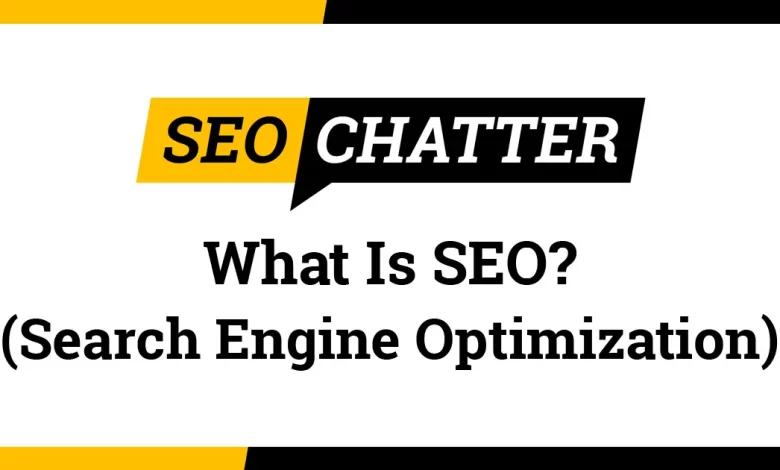What Is SEO? Basics of Search Engine Optimization Explained-SEO

This guide answers the question, “what is SEO?”, which stands for search engine optimization.
Below, you’ll get the basic definition of SEO, an explanation of why it’s important, details about how SEO works for websites, and the top factors that affect SEO performance.
There’s also a section with tips and techniques on how you can improve your site’s SEO so it ranks higher in search engines like Google, Yahoo, and Bing.
Please enable JavaScript
What Is SEO? (Search Engine Optimization)
SEO stands for search engine optimization, which is a set of practices that help your website rank higher in the organic search results of Google and other search engines. SEO can increase your visibility, credibility, and traffic by matching your content with the search intent of your target audience.
That’s the formal search engine optimization definition for anyone who is looking for a basic understanding of what is SEO and how it works. In terms of what is search engine optimization as it relates to paid traffic and unpaid traffic, here are some additional details about what does SEO mean:
You can think of SEO as a broad set of search engine optimization strategies that target organic rankings in Google, Yahoo, and Bing. Organic search traffic rankings are the unpaid listings that appear in the search engine results page (SERP) which closely match the user’s search query based on relevance.
Unpaid website traffic can originate from different kinds of searches, including text search, image search, and video search.
When Webmasters and content providers do SEO correctly, they can rank a web page in the top 10 search results on Google for specific keywords and phrases. And this Internet marketing strategy can increase the number of people who see the content and click on the link to view it from the search results.
Why Is SEO Important?
SEO is important because it helps your website rank higher in SERPs to gain more search engine visibility. A website with top positions for keywords also has increased trust with search engines and its users. Search engine optimization is an important part of building better relationships online.
How Does SEO Work?
SEO works by optimizing specific on-site and off-site factors for certain keywords. When optimized correctly, a search engine will rank a page higher for those target keywords. Search engine optimization works on numerous factors, including SEO keyword placement, content quality, number of backlinks, site trust, and authority.
The first part of the SEO process starts with a search engine spider (or web crawler) crawling the web page and then taking that information it finds back to a series of algorithms for processing. These are the on-page (or on-site) signals for ranking.
The next step of the process is to take into account the off-page (or off-site) signals like inbound links and process those factors with the algorithms.
The final step in the SEO work is to compare all of the indexed pages against each other to determine the order for how all of the content should be ranked in the search engine for a given query.
According to Google, “Search algorithms look at many factors, including the words of your query, relevance and usability of pages, expertise of sources, and your location and settings.” It goes on to say, “if other prominent websites link to the page (what is known as PageRank), that has proven to be a good sign that the information is well trusted.”
PageRank is a metric based on the quantity and strength of inbound links. It was developed in 1998 by Larry Page and Sergey Brin, who developed the “Backrub” search engine (now called “Google”) that used a mathematical algorithm to rate the prominence of web pages on the Internet.
PageRank is now just one of the 200+ ranking factors Google uses to evaluate and rank websites in the search engine results pages for keyword queries. For more details about the working of SEO, check out my guide on how does SEO work here.
SEO Example
Here’s an example of a web page that has been optimized correctly to rank high for its target SEO keywords. As you can see in the image below, this website is ranking in the top 10 search results for the keyword phrase “best SEO books”.

This is a good example of SEO because the web page has been optimized the right way for a specific phrase. (See my article on article on what is SEO writing to learn more about this type of content writing.)
Search engine optimization like this helps to maximize the number of visitors to the website by ensuring that the pages appear high on the list of results returned by a search engine. This type of website traffic is called “SEO traffic”, which you can find out more about in my post on what is SEO traffic.

Main Factors That Affect SEO
On-Page SEO
On-page SEO is also referred to as on-site SEO. And this type of search engine optimization is directly focused on optimizing the HTML code and content on your website.
On-page SEO includes your adding your target keywords to specific areas of the HTML document for a web crawler to scan and index. This Internet marketing strategy helps the content rank higher on the search engine results page for certain keywords.
Elements that you can optimize for on-page SEO include:
- Meta tags
- URLs
- Headers
- Body content
- Images
- Navigation menus
- Internal links
- HTML attributes
See my guide on what is on-page SEO for more details.
Off-Page SEO
Off-page SEO is a type of SEO that’s also referred to as off-site SEO. And this type of SEO is all about increasing the exposure and trust for your website through brand mentions and indexed links that point back to your web pages.
When Webmasters and content providers mention off-page SEO, they’re primarily referring to link building (or inbound links), but it includes much more than that.

Off-page SEO examples include:
- Guest posting
- Natural backlinks
- Business profile links
- Social media shares
- Website reviews
- Brand mentions
See my guide on what is off-page SEO for more details on these categories of SEO factors.
Technical SEO
Technical SEO refers to website and server optimizations that help a search engine web crawler scan and index your site more effectively.
By making your website easier to crawl and understandable for a search engine, you can achieve higher rankings throughout the entire site.
The core factors of Technical SEO include:
- Page speed
- Optimized robots.txt file
- Crawlable XML sitemap
- Site structure
- URL structure
- SEO-friendly web design
- Schema Markup
- Proper redirects
See my guide on what is technical SEO for more details on this category of SEO.
Content SEO
Content SEO is a subset of on-page SEO. However, content SEO refers to the quality of the content and how well it meets the needs of the searcher.
If you have good on-page SEO but poor content, you won’t rank as high—or very long—on the search engine results page for your target keywords.
Publishing the type of content that meets a user’s search intent in addition to optimizing it correctly with on-page SEO is critical for getting indexed and ranking on Google.
Good content SEO includes:
- Publishing well-researched content
- Answering the most important questions people have about the topic
- Using images, videos, and audio when appropriate
- Having tables and charts to support data
- Writing long enough content to satisfy the search query
- Having all of the right sections to improve topical relevance
- Cross linking between relevant pages on the website
To learn more about content and SEO, check out my guide on what is SEO content.
Local SEO
Local SEO is a special type of SEO that solely focuses on a specific local area, rather than national or international locations. The goal of local SEO is to increase a website’s presence in a particular community and promoting products or services to local customers.
Local SEO is targeted through:
- Google My Business Listings
- Local business directories
- Business review sites
- NAP (name, address, phone number) information
One thing to keep in mind as a Webmaster or content provider is that local SEO is different than traditional organic SEO. Local SEO focuses on local businesses while organic SEO can be global, national, or local in scope.
To learn more about these topics, read my guides on what is local SEO, what is organic SEO, and what is international SEO.
Mobile SEO
Mobile SEO is a specific subset of search engine optimization that focuses on mobile devices.
Today, Google predominantly uses the mobile version of the content for indexing and ranking and gives Webmasters and content providers recommendations on mobile-first indexing best practices.
When working on Mobile SEO, you need to focus on:
- Having a mobile-friendly website
- A site that loads fast on mobile devices
- Using the same meta robots tags on the mobile and desktop site
- Don’t lazy-load primary content upon user interaction
- Making sure your mobile and desktop sites have the same structured data
- Using high-quality images
- Following good on-page SEO practices
To learn more about mobile optimization, check out my guide on what is mobile SEO here.
White Hat SEO
White hat SEO is the purest form of search engine optimization in Internet marketing. It follows a set of strategies that improve a website’s rankings on the search engine results page (SERP) without violating the rules of the search engine provider.
To learn more about this type of SEO, check out my guide on what is white hat SEO here.
Black Hat SEO
Black hat SEO is a form of search engine optimization that violates the search engine guidelines to increase the keyword rankings for a website on the SERPs. It’s commonly referred to as spamdexing because it’s using spamming methods to manipulate algorithms and indexes.
To learn more about this category of SEO, check out my guide on what is black hat SEO here.

Grey Hat SEO
Grey hat SEO is a combination of white hat and black hat SEO methods. However, it’s mostly black hat techniques masquerading as white hat practices.
To learn more about this type of SEO, check out my guide on what is grey hat SEO here.
How Can You Improve Your SEO?
Conduct Keyword Research
Find out what words and phrases your target audience is using to search for your niche or industry and create content that targets those keywords. Use tools like Google Keyword Planner, Moz Keyword Explorer, or Semrush Keyword Magic to find relevant keywords with high search volume and low competition.
Write High-Quality Content
Create content that meets the user search intent, is authoritative, and engaging for your readers and search engines. Provide value to your audience by answering their questions, solving their problems, or fulfilling their needs in a way that’s higher quality than the current top-ranking web pages for the target keywords.
Improve On-Page SEO Signals
Make sure your target keywords for SEO are placed in the most important elements for on-page SEO: title tag, meta description, URL, H1, H2, and body content.
Optimize Your Images
Use descriptive ALT text for images in the content that describes what the image shows and includes your main keywords if relevant. Also, reduce the file size of your images by using tools like TinyPNG or ImageOptim to compress them without losing quality.
Improve Your Site Speed
Use caching to store static files on your server or browser and reduce loading time. Use compression to reduce the size of your HTML, CSS, and JavaScript files by removing unnecessary characters. Use minification to combine multiple files into one file and reduce HTTP requests.
Make Your Website Mobile-Friendly
Use a responsive design that automatically adjusts the layout and content of your site according to the device used. Avoid pop-ups or intrusive interstitials that can block the user’s view or interfere with their experience. Test your site on different devices using tools like Google Mobile-Friendly Test or BrowserStack to make sure it is mobile-friendly.
Build Links from Other Reputable Websites
Create valuable content that attracts natural links from other websites that find it useful or interesting. Reach out to relevant websites in your niche or industry and offer them guest posts or collaborations in exchange for a link back to your site. Participate in online communities where you can share your content and build relationships that lead to high-quality, organic backlinks.
Encourage Social Media Engagement
Share your content on different social media platforms where your target audience is active. Use catchy headlines, images, videos, hashtags, etc, to grab attention and spark interest in your content to get likes, comments, and shares. Invite feedback from your followers by asking questions, running polls, or hosting contests that encourage people to visit your web pages, link back to them, and share the content on their own social accounts.
Update Your Content Regularly
Keep your content fresh and relevant by updating it regularly with new information, data, examples, etc. This can help improve your rankings and attract more visitors to your site. You can also repurpose your old content into new formats like videos, podcasts, infographics, etc, to create fresh content that’s optimized for SEO on other platforms that lead back to your site.
Monitor Your SEO Performance
Use tools like Google Analytics, Google Search Console, or Moz Pro to measure your SEO performance and get insights into your traffic, rankings, conversions, etc. Analyze your data and identify areas for improvement or opportunities for growth.
Follow SEO Best Practices and Guidelines
Stay updated with the latest SEO trends and changes in the search engine algorithms. Follow the SEO best practices and guidelines from Google’s official Search Essentials (formerly Webmaster Guidelines). Avoid using black hat SEO techniques that can harm your site or get you penalized.
SEO (Search Engine Optimization) Explained Summary
I hope you enjoyed this guide on what is SEO and how it works.
As you discovered, SEO stands for search engine optimization, which is a set of practices that help your website rank higher in the organic search results of Google and other search engines. And, when optimized properly, SEO can increase your website’s visibility, credibility, and traffic by matching your content with the search intent of your target audience.
Stephen Hockman is an entrepreneur and founder of SEO Chatter. He specializes in search engine optimization and digital marketing and has been fascinated with SEO since 2005. His goal is to share the best tips and news about search engine marketing to help you get more website traffic.
#SEO #Basics #Search #Engine #Optimization #Explained




